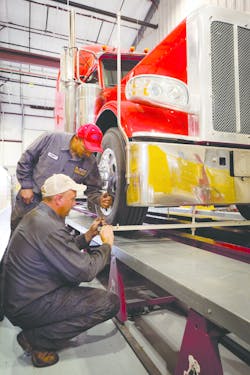How do you assess your technician staffing requirements? Do you rely on a gut feeling? Do you “just know” that current staffing levels are fine?
A more precise way to determine the appropriate staffing level for a fleet maintenance facility is to employ a methodology – and there are a number of these, as this eliminates any subjectivity.
Before utilizing a particular method, it is advisable to evaluate technicians to ascertain if they are performing at peak efficiency, given their experience level when compared to peers and industry benchmarking measures. At the same time, check to see that the technicians have the proper and sufficient number of tools, shop equipment and work space needed to work most efficiently.
The most productive vehicle maintenance organizations do this periodically.
A Best Practice
The Technology & Maintenance Council (TMC) has created a method for calculating maintenance staffing levels. It is Recommended Practice 512A, Technician Staffing Determination.
TMC (www.trucking.org/Technology_Council.aspx) is an industry association focused on improving transport equipment, its maintenance and maintenance management.
RP 512A provides a basic formula to calculate the number of technicians required to adequately staff a vehicle maintenance shop. There is also a worksheet to help work through the process.
These are the basic steps:
- Step 1 – Determine the vehicle labor hours needed. TMC defines vehicle labor hours as the total amount of labor hours – both internal and those of a vendor – used to maintain and repair a vehicle or piece of equipment.
Vehicle labor hours are figured by dividing the total vehicle labor hours per day by the number of assets for each type, make, vehicle class and model year of vehicle or piece of equipment. - Step 2 – Separately figure the total vehicle labor hours needed for each type, make, vehicle class and model year of vehicle or piece of equipment, and then add results.
- Step 3 – Calculate the number of available direct labor hours. Direct labor hours is the actual time spent by a technician to maintain and repair a vehicle or piece of equipment, according to TMC RP512A. This does not include tasks such as parts handling, shop clean-up time, etc.
- Step 4 – Determine the number of technicians required. This is done by taking the total number of vehicle labor hours needed per day to cover the work, and dividing this amount by the amount of the direct labor hours per day.
Mileage Makes a Difference
Fleet mileage can have an influence on technician staffing.
“If the mileage the fleet runs changes significantly, the technician staffing model can be adjusted by dividing the total vehicle labor hours needed by the daily fleet mileage,” the RP 512A Technician Staffing Determination says. “This will give the vehicle labor hours per mile.
“Multiply that number by the projected mileage figure to determine the total vehicle labor hours needed due to the mileage increase or decrease. Use that number for the total vehicle labor hours needed in the number of technician calculation.”
The RP notes that this will be accurate only if all of the maintenance is mileage driven. If a part of the maintenance is driven by time, it must be factored into the formula.
About the Author

